
Dazed & Amazed
There was at least one Minnesotan excited to see snow on Wednesday. My youngest son took a few days off from Navy aviation, got off the plane and promptly tweeted photos of the snow to his friends in Pensacola, Florida. The excitement was palpable. He may have been the ONLY person happy to see big, fat flakes falling in mid-April.
Another head-shaking, jaw-dropping weather moment – a 20 inch variation in snow; from a coating of slush at MSP International to 20 inches at North Branch. Wow.
Any slush in your yard is doomed, considering the sun is as high in the sky as it was on August 24. Spring isn’t on a dimmer switch; it’s either ON or OFF.
Our temperature roller coaster reverses course, topping 50F today; 60s likely this weekend with a late-day thundershower possible Saturday. As the front stalls a shower may linger on Easter Sunday. At least it’ll be a lukewarm rain.
The extended outlook next week calls for bright green: a streak of balmy 60s leading up to heavy showers/storms by Wednesday & Thursday.
According to Rhett Bollinger at MLB.com yesterday’s 31F reading at Target Field made it the coldest Twins game on record. Is snow season over? I think so.
Place your bets.
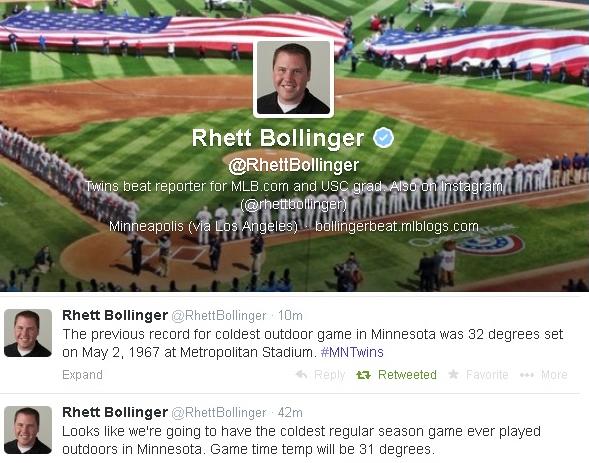
Coldest Twins Game On Record? According to Rhett Bollinger, Twins beat reporter for MLB.com, yesterday’s midday temperature for the game at Target Field was a crisp 31F, beating the previous cold weather record of 32F, on May 2, 1967 at Met Stadium. May you live in interesting times. Yep.

Snowfall Summary. With any luck (and hours of prayer and meditation) may this be the LAST time I post a snowfall map for the next 6 months. The northern and western suburbs did, in fact, see plowable amounts, the heaviest (15″+) amounts between Isanti and Taylors Falls and Hinckley. Source: National Weather Service.
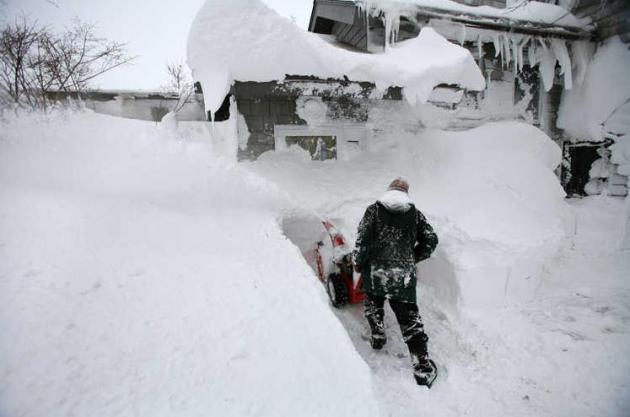
5th Snowiest Season On Record At Duluth. Here is more information from the Duluth National Weather Service: “As of April 17th, the seasonal snowfall total for Duluth is 125.3 inches which is now the 5th most in recorded history. The following is a list of the top 5 snowiest seasons on record at Duluth.
1. 135.4 inches 1995-1996
2. 131.8 inches 1949-1950
3. 129.4 inches 2012-2013
4. 128.6 inches 1996-1997
5. 125.3 inches 2013-2014
* file photo above courtesy of Brian Peterson at The Star Tribune.

Shifting Gears. The jet stream is finally pushing north, an expanding ridge of high pressure allowing warmer air to reach northern cities again much of next week, sparking a few spirited rounds of showers and T-storms. Meanwhile a disturbance in the Gulf of Mexico will soak the Florida Panhandle and much of the Southeast, with more flash flooding likely. A Pacific storm pushes heavy rain into the Seattle and Portland, but little or no appreciable rain is likely across California. NAM Future Radar: NOAA and HAMweather.
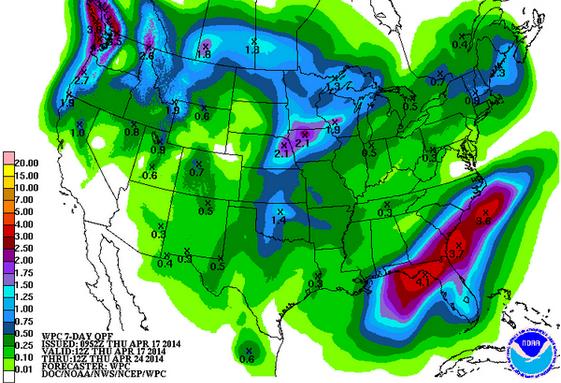
Shifting Gears – Rapidly. I’m continually amazed by how quickly the patterns can shift. Exhibit A: next week, as warm air surges north, sparking waves of heavy showers and T-storms over the Midwest, capable of 1-2″ of rain. The heaviest rains over the next week are forecast to soak the Pacific Northwest and parts of the Southeast. 7-Day rainfall guidance through 12z next Thursday courtesy of NOAA.

Will Spring Stick This Time? After a few false starts, our on-again, off-again spring appears to be on again, with temperatures forecast to be above average much of next week, cooling off in about 1 week. No snow in the extended forecast, I’m happy to report. ECMWF guidance shows highs near 70F Easter Sunday, again Monday, with the best chance of (potentially heavy) showers and T-storms Wednesday into early Thursday. Graphic: Weatherspark.

Pollution From Asia Makes Pacific Storms Stronger. It’s all about the aerosols, man-made pollutants seeding clouds and ultimately storms hundreds, even thousands of miles downwind. Is Chinese pollution impacting our weather? Here’s a clip from National Geographic: “…Whether the weather [in North America] will change in a good direction or bad is hard to say at this time,” says Renyi Zhang, a professor of atmospheric sciences at Texas A&M University in College Station. Zhang is a co-author, along with several scientists from the U.S. and China, of a study released in the Proceedings of the National Academy of Sciences on Monday. The scientists say pollution from Asia is likely leading to stronger cyclones in the midlatitudes of the Pacific, more precipitation, and a faster movement of heat from the tropics toward the North Pole. As a result of these changes, “it’s almost certain that weather in the U.S. is changing,” says Zhang…”

Hurricane Survey: Water’s The Threat, But Most Still Fear Wind. By emphasizing wind speed vs. predicted storm surge over the years, meteorologists may be at least partly to blame for this misperception. The Palm Beach Post has the story; here’s the intro: “Despite all the public education, a staggering 84 percent of people surveyed still believe wind, not water, is the greatest threat to their safey, and base their evacuation decisions on wind speed or a storm’s category, the Federal Alliance for Safe Homes said this week….”

TSR Lowers 2014 Atlantic Hurricane Season Forecast, Cites El Nino. Although all El Nino warming phases of ENSO are different, MOST increase winds over the tropics while cooling Caribbean waters slightly, lowering the risk of hurricanes over an “average” year. Here’s an excerpt from artemis.bm: “…With the update published yesterday, TSR’s Professor Mark Saunders and Dr. Adam Lea have reduced their forecast to 12 named storms, 5 hurricanes and 2 major (Category 3+) hurricanes, which is around 25% below the 1950-2013 norm and 40% below the more recent 2004-2013 norm. The forecasters cite two factors as leading the forecasters to believe that 2014 will be a below-average year for Atlantic hurricane formation…”
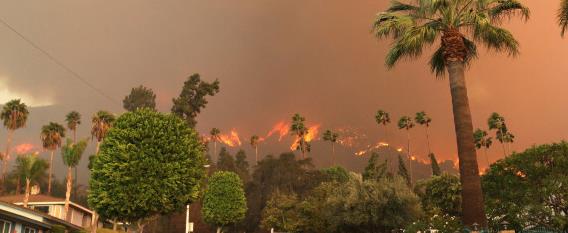
California’s Wildfire Threat Is So Severe That The Season Started Early. Following a deepening drought and unusual heat during the winter months, 2014 promises to be a very rough year on the wildfire front. Here’s an excerpt from Huffington Post: “Don’t let the recent rains and green hillsides fool you — the California Department of Forestry and Fire Protection says the fresh growth is only covering up months of dry, dead grass, putting California at risk for one of its most severe fire seasons ever. Warnings issued to homeowners in the state’s most wildfire-prone areas urged them to prepare earlier than ever for the summer fire season in light of California’s historic drought, ABC News 10 reported…”
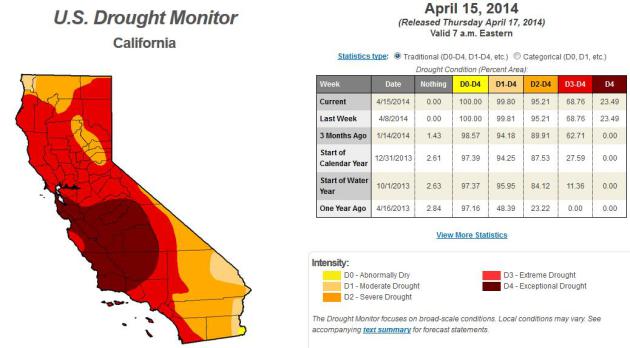
California Drought To Push Produce Prices Higher. AZCentral has the story; here’s an excerpt: “Drought conditions in California’s agricultural fields are going to push prices higher for fruits and vegetables, according to a Arizona State University study. The biggest price hikes are likely for lettuce, up 34 percent, and avocados, up 28 percent, according to Professor Timothy Richards of W. P. Carey School of Business at ASU. “You’re probably going to see the biggest produce price increases on avocados, berries, broccoli, grapes, lettuce, melons, peppers, tomatoes and packaged salads,” Richards said…”
* latest U.S. Drought Monitor for California is here.
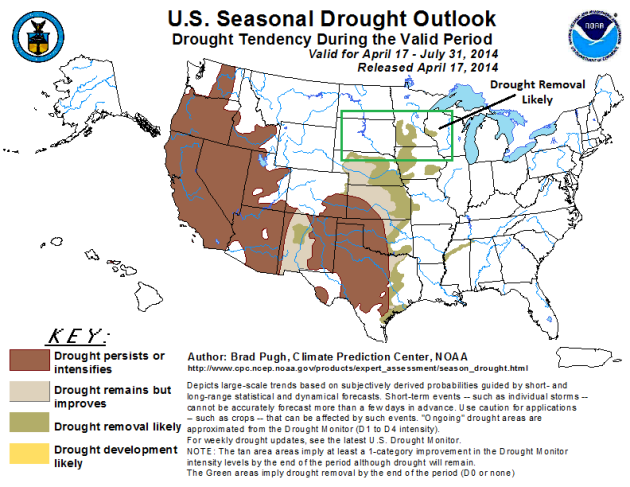
Silver Lining. Those piles of April slush lingering in your yard have some benefits: they’ve delayed allergy season, and moisture is trending above average. NOAA may remove the drought designation for parts of central and southwestern Minnesota in the coming weeks if these (wetter than normal) trends continue.
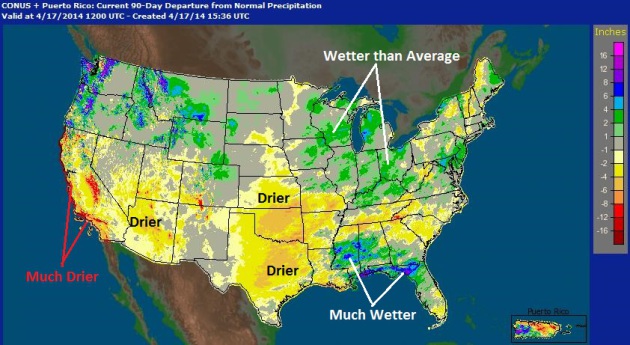
Encouraging Moisture Trends Midwest, Great Lakes & Ohio Valley. Here is the 90-day departure from normal precipitation composite, courtesy of NOAA. The Plains continue to dry out, along with portions of the Mid South and Southeast, much drier than average, overall, for California.
Despite all the public education, a staggering 84 percent of people surveyed still believe wind, not water,is the greatest threat to their safety, and base their evacuation decisions on wind speed or a storm’s category, the Federal Alliance for Safe Homes said this week.
The national Harris Interactive Survey, commissioned by the nonprofit group FLASH, revealed “frightening perceptions,” FLASH said Tuesday in a release.
The survey clashes with the reality that hurricane evacuation zones are based on the threat of water, not wind, and nearly all evacuation orders reflect the threat of inland flooding and storm surge.
– See more at: http://blogs.palmbeachpost.com/eyeonthestorm/2014/04/15/hurricane-survey-waters-the-threat-but-most-fear-wind/#sthash.6UHHm3wb.dpuf
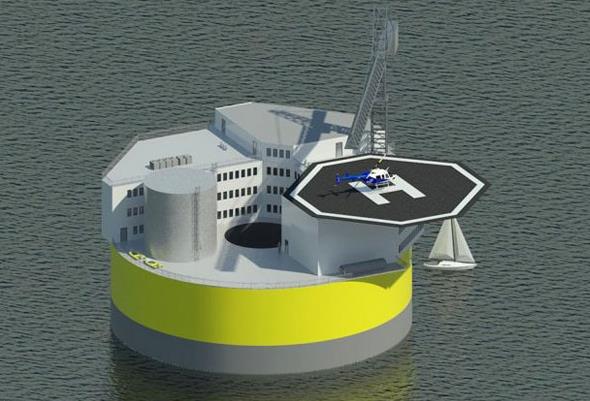
MIT Designs A Floating, Tsunami-Proof Nuclear Plant. Well, I guess this makes sense on many levels, but romping on the beach I can’t say it would be comforting watching a nuclear power plant bobbing on the horizon. Then again, we’re going to need some safe, viable nuclear options to power our economy to avoid the worst impacts of climate change. Here’s a clip from Engadget: “What’s the safest place to put a nuclear reactor? Offshore, apparently. A new power plant design concept from MIT envisions a facility built on floating platforms, moored in deep water several miles off the coast. This, the concept’s creators explain, lends it several crucial advantages — making it virtually immune to earthquakes, tsunamis and meltdowns…”

Amazon And Google Are In An Epic Battle To Dominate The Cloud – And Amazon May Already Have Won. Our companies use Amazon’s AWS cloud-based services, but we’re taking a hard look at Google as well. Here’s a clip from another interesting read at Quartz: “…To understand the scale of the war brewing between them, it helps to understand that what Amazon and Google are really contesting is who gets to eat a bigger portion of the total corporate information-technology pie. All the warehouses of servers that run the whole of the internet, all the software used by companies the world over, and all the other IT services companies hire others to provide, or which they provide internally, will be worth some $1.4 trillion in 2014, according to Gartner Research—some six times Google and Amazon’s combined annual revenue last year…”
Photo credit above: “Let’s do this.” AP Photo/Rick Bowmer.

The 2,000-Year History of GPS Tracking. Here’s an excerpt of a fascinating story (and book review) from Mother Jones: “Boston Globe technology writer Hiawatha Bray recalls the moment that inspired him to write his new book, You Are Here: From the Compass to GPS, the History and Future of How We Find Ourselves. “I got a phone around 2003 or so,” he says. “And when you turned the phone on—it was a Verizon dumb phone, it wasn’t anything fancy—it said, ‘GPS’. And I said, ‘GPS? There’s GPS in my phone?'” He asked around and discovered that yes, there was GPS in his phone, due to a 1994 FCC ruling. At the time, cellphone usage was increasing rapidly, but 911 and other emergency responders could only accurately track the location of land line callers...”
Image credit above: “Egyptian geographer Claudius Ptolemy and Hiawatha Bray’s “You Are Here“. Basic Books; Wikimedia Commons; Shutterstock/MeeKo.
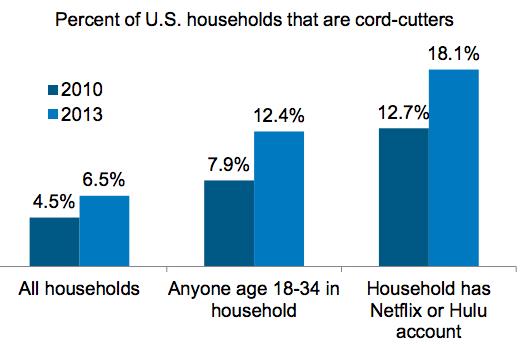
Proof That Neflix Is Destroying Cable TV. Have you officially “cut the cord” yet? Is Netflix, Amazon, Hulu and Roku providing most of the content you watch on a daily basis? Here’s a clip from a story at Business Insider: “A new report from consumer data company Experian Marketing Services suggests that online video content services like Netflix are pulling people away from cable television. After surveying more than 24,000 U.S. adults, EMS found that households with a Netflix or Hulu subscription were nearly three times as likely not to have a cable subscription than the average household. In total, 6.5% of Experian’s surveyed households did not subscribe to cable in 2013, up from 4.5% in 2010. But cord-cutters became 18.1% of Netflix subscribers, up from 12.7%. Cord-cutters are three times as likely to be Netflix subscribers than the average consumer, in other words…”
Graphic credit: Experian Marketing Services.
42 F. high in the Twin Cities Thursday.
59 F. average high on April 17.
42 F. high on April 17, 2013.

GOOD FRIDAY: Fading sun, a bit milder. Winds: SE 10-15. High: 52
FRIDAY NIGHT: Partly cloudy. Low: 38
SATURDAY: Springy with early sun giving way to increasing clouds. PM thundershowers. High: 67
EASTER SUNDAY: Some mild sun, lingering shower or two. Wake-up: 48. High: 68
MONDAY: Partly sunny. Risk of spring fever. Wake-up: 43. High: near 70
TUESDAY: Sunny, breezy, a bit cooler. Wake-up: 41. High: 59
WEDNESDAY: Unsettled. Showers and T-storms likely. Wake-up: 43. High: 57
THURSDAY: Heavy rain tapers to showers. Wake-up: 47. High: 61
Climate Stories….
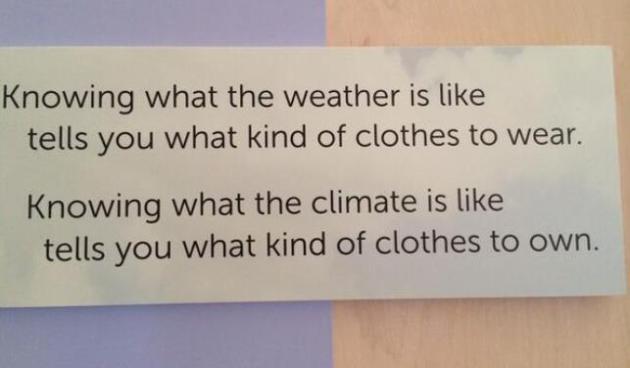
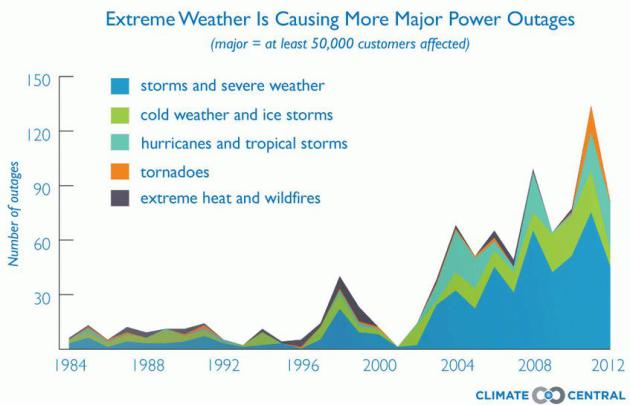
Weather-Related Blackouts Doubled Since 2003: Report. A ten-fold increase in major power outages between the mid-80s and 2012? Here’s the introduction to a disturbing report, summarized at Climate Central: “Climate change is causing an increase in many types of extreme weather. Heat waves are hotter, heavy rain events are heavier, and winter storms have increased in both frequency and intensity. To date, these kinds of severe weather are among the leading causes of large-scale power outages in the United States. Climate change will increase the risk of more violent weather and more frequent damage to our electrical system, affecting hundreds of millions of people, and costing Americans and the economy tens of billions of dollars each year...”
* Climate Central has a detailed 23 page report on power outage trends and the link to increasing outbreaks of severe weather impacting the grid here (PDF).
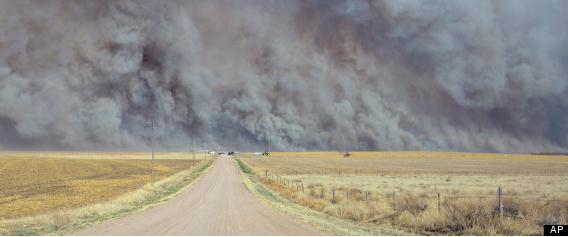
More, Bigger Wildfires Burning Western U.S. – Study Shows. Here’s an excerpt from an interesting story at phys.org: “…The Number of wildfires over 1,000 acres in size in the region stretching from Nebraska to California increased by a rate of seven fires a year from 1984 to 2011, according to a new study accepted for publication in Geophysical Research Letters, a journal published by the American Geophysical Union. The total area these fires burned increased at a rate of nearly 90,000 acres a year – an area the size of Las Vegas, according to the study…” (File photo: AP).
The number of wildfires over 1,000 acres in size in the region stretching from Nebraska to California increased by a rate of seven fires a year from 1984 to 2011, according to a new study accepted for publication in Geophysical Research Letters, a journal published by the American Geophysical Union.
The total area these fires burned increased at a rate of nearly 90,000 acres a year – an area the size of Las Vegas, according to the study. Individually, the largest wildfires grew at a rate of 350 acres a year, the new research says.
Read more at: http://phys.org/news/2014-04-bigger-wildfires-western.html#jCp
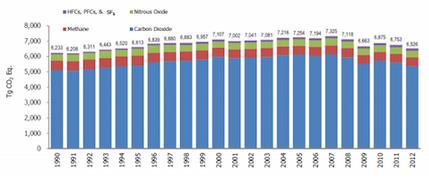
U.S. GHG Emissions At Lowest Levels In 20 Years. The trends are encouraging in the USA, but any drop in carbon pollution here has been more than offset by spiking greenhouse gas emissions in China, India and other rapidly developing nations. Here’s a clip from Climate Central: “U.S. greenhouse gas emissions declined 3.4 percent in 2012 from 2011, the Environmental Protection Agency announced Tuesday. Those emissions are down 10 percent from what they were in 2005, the EPA said, and are at their lowest levels since 1994. Most of the decline came from reductions in energy consumption, increased fuel efficiency of cars and other types of transportation, and a shift to natural gas from coal in fueling power plants, the EPA said in a statement...”
Graphic credit above: “U.S. greenhouse gas emissions per year since 1990, broken down by type of gas.”
Credit: EPA.
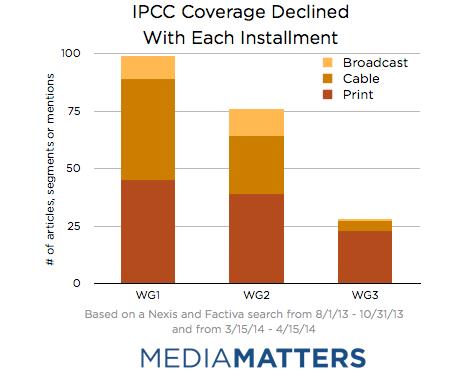
Analysis: How The Media Covered The U.N. Climate Reports In Three Charts. Are we losing interest or avoiding the subject altogether? Here’s an excerpt from Media Matters: “…A Media Matters analysis found that the major print and television outlets devoted far less coverage to the most recent installment of the IPCC report than the first two reports by Working Group 1 (WG1) and Working Group 2 (WG2), which outlined the evidence that manmade climate change is happening and having largely negative impacts, respectively. The third report received only about a quarter (28 percent) of the amount of coverage given to the first report…”

U.N. Climate Report Was Censored. Or at least very watered down for public consumption, it seems. This, according to an article at Grist; here’s an excerpt: “…And it turns out the summary was watered down — diluted from an acid reflux–inducing stew of unpalatable science into a more appetizing consommé of half-truth. The Sydney Morning Herald has the details: A major climate report presented to the world was censored by the very governments who requested it, frustrating and angering some of its lead authors. … [E]ntire paragraphs, plus graphs showing where carbon emissions have been increasing the fastest, were deleted from the summary during a week’s debate prior to its release. Other sections had their meaning and purpose significantly diluted... (Image credit: Shutterstock).

It’s The End Of The World As We Know It…And He Feels Fine. Is it too late to do anything? I sure hope not – it may be a sense of naive optimism, but I suspect we can still avoid a worst-case scenario. Here’s an excerpt of a long and sobering story at The New York Times Magazine: “…For Kingsnorth, the notion that technology will stave off the most catastrophic effects of global warming is not just wrong, it’s repellent — a distortion of the proper relationship between humans and the natural world and evidence that in the throes of crisis, many environmentalists have abandoned the principle that “nature has some intrinsic, inherent value beyond the instrumental.” If we lose sight of that ideal in the name of saving civilization, he argues, if we allow ourselves to erect wind farms on every mountain and solar arrays in every desert, we will be accepting a Faustian bargain…”


